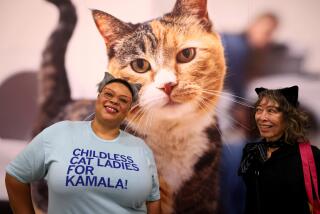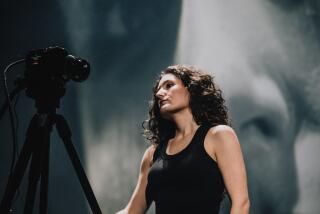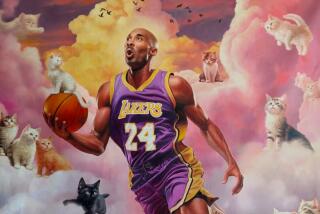Flying fur balls and puffed-up divas too
- Share via
MOVE over, Garfield, Morris and Felix. There’s a new posse of spotlight-seeking pusses in town that are scratching for top cat status.
With shows starting this weekend, the Moscow Cats Theatre features the typical assortment of circus skills such as tightrope walking, balancing and acrobatics -- but they’re all performed by a cast of 30 felines, with a pair of dogs and some human clowns thrown in for good measure.
For many, “performing cats” seems like an oxymoron. Oh sure, the fluffy beasts can meow on cue when the cat food can is being opened, but to get them to balance balls on their noses or climb poles in precise synchronization? Impossible. After all, it’s a cat’s world, and we humans just live in it, right?
Not quite, says Yuri Kuklachev, artistic director of the theater who has been incorporating felines into his clown act since 1973. His traveling menagerie has performed in 80 countries, while his Cat Theatre in Moscow is the hot ticket in town.
Though Kuklachev acknowledges that cats won’t obey unless they want to, there are proven methods to gently coax the whiskered wonders to the center stage. He won’t reveal all his tabby-teaching techniques, but he says it’s really rather simple: To train cats, you’ve got to love and play with them.
“Cats are playful creatures by nature, so I observe them since they are babies to see the kind of games they prefer and base my tricks around that natural skill,” Kuklachev says via e-mail through a translator from Moscow. “Cats are capable of being taught tricks, but only in a very specific way. [Much] can be accomplished with a lot of love, petting and special treats.”
Indeed, Kuklachev witnessed this feline fact himself many years ago when he was a struggling student at the Russian National Clown University. He was wandering the streets of Moscow trying to figure out how to make his ordinary clown act stand out from the crowd. His teachers didn’t have much faith in him, but Kuklachev was determined to give audiences something they’d never seen before.
Kuklachev then recalls seeing “a cat performing a trick on the street for food. People couldn’t help but stop and feed the kitty for doing a simple jump on command.”
Inspired, Kuklachev thought long and hard about that incident. He and his wife, dancer Elena Isaakovna, later found an abandoned kitten. After nursing it back to health, the kitten became part of their onstage act, and ecstatic crowds demanded more clown-and-cat interaction.
Soon, invitations came from all over the world; in the 1970s Kuklachev and a company of many cats toured Romania, Cuba and Canada, and then finally back at the bright lights of the prestigious Moscow Circus. An old teacher of Kuklachev’s -- one who originally thought the former student didn’t have the right stuff for clowning -- came backstage after a show and apologized profusely.
“I embraced him and thanked him for the hardships he used to create for me,” Kuklachev writes in his autobiography, “Lessons of Kindness.” “I said, ‘You made me choose not a well-trodden path where I would have most likely got lost in drab uniformity.’ Even now I am so grateful to those people who did not praise me.... “
Armed with a purpose and a growing army of cats, Kuklachev opened his 300-seat theater in 1993 and set about breeding new performers, inventing original scenarios for his up-and-coming stars and starlets and caring for his retired divas.
“I always let them live out their natural life after being stars in my theater,” he says.
TODAY, there are nine different shows that feature some of the more than 100 cats that live in the theater. The programs vary in storyline and theme, but all contain a language-less presentation with plenty of leaping, balancing and comedy -- and perhaps one of the most difficult cat stunts of all: the front paw stand.
“This is a demanding trick with a lot of training time,” Kuklachev says. “Maybe 1 out of 200 or more cats can do it.”
Overall, the theater business is a family affair: Kuklachev’s son Dmitri is the principal assistant and also performs solo with as many as 50 to 70 cats; daughter Katerina is the chief art director. Another son, Vladimir, is a dancer at the Panov Ballet Theatre in Israel.
More important, Kuklachev sees himself today as more than just an accomplished clown and animal trainer. He believes his theater is a reflection and encouragement for the simple acts of kindness that extend beyond human and animal connections.
“[Cats] must have come from some other world to soften our hearts,” he says in another interview about his book. “[The book] is an attempt to teach children to listen to their hearts -- as my cats taught me -- to hear silence, to see the invisible, to see with one’s heart.”
*
Moscow Cats Theatre
Where: Wilshire Ebell Theatre, 4401 W. 8th St., L.A.
When: 7 p.m. Friday, 1 and 4 p.m. Sunday, and 1 and 4 p.m. Dec. 3
Price: $49.90 and $57.90
Info: (213) 365-3500, www.moscowcatstheatre.com.
More to Read
The biggest entertainment stories
Get our big stories about Hollywood, film, television, music, arts, culture and more right in your inbox as soon as they publish.
You may occasionally receive promotional content from the Los Angeles Times.










